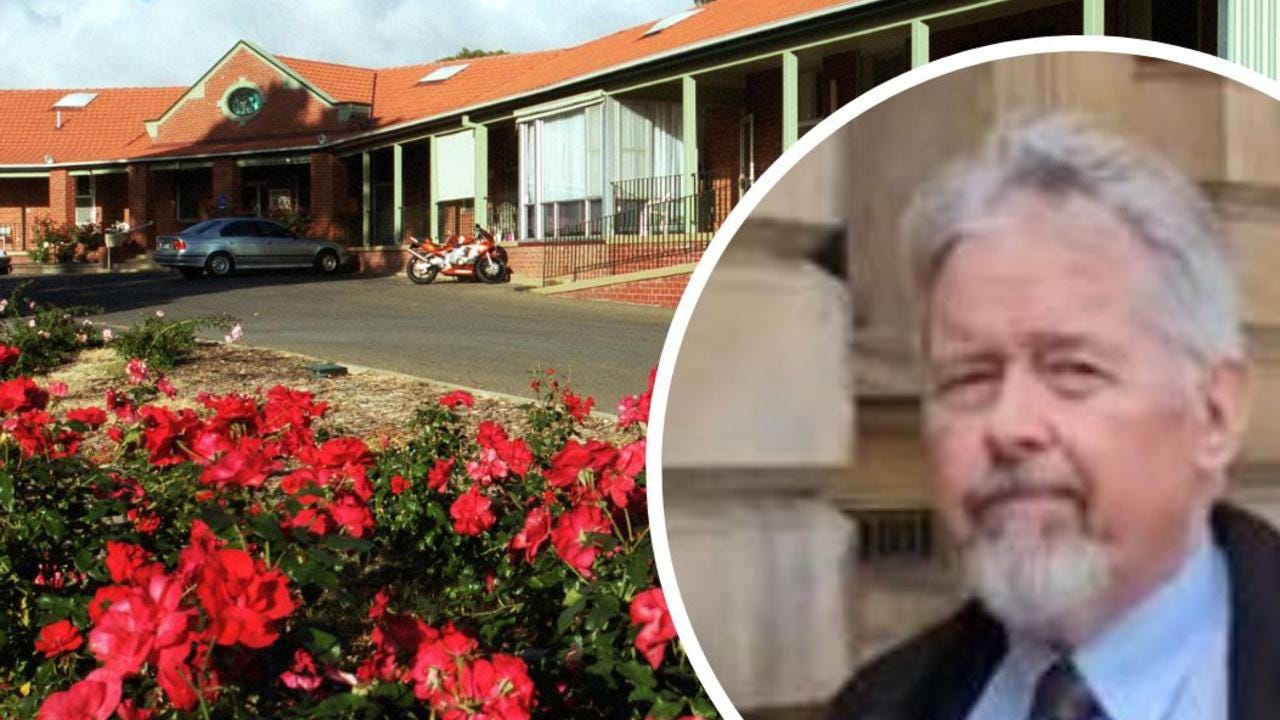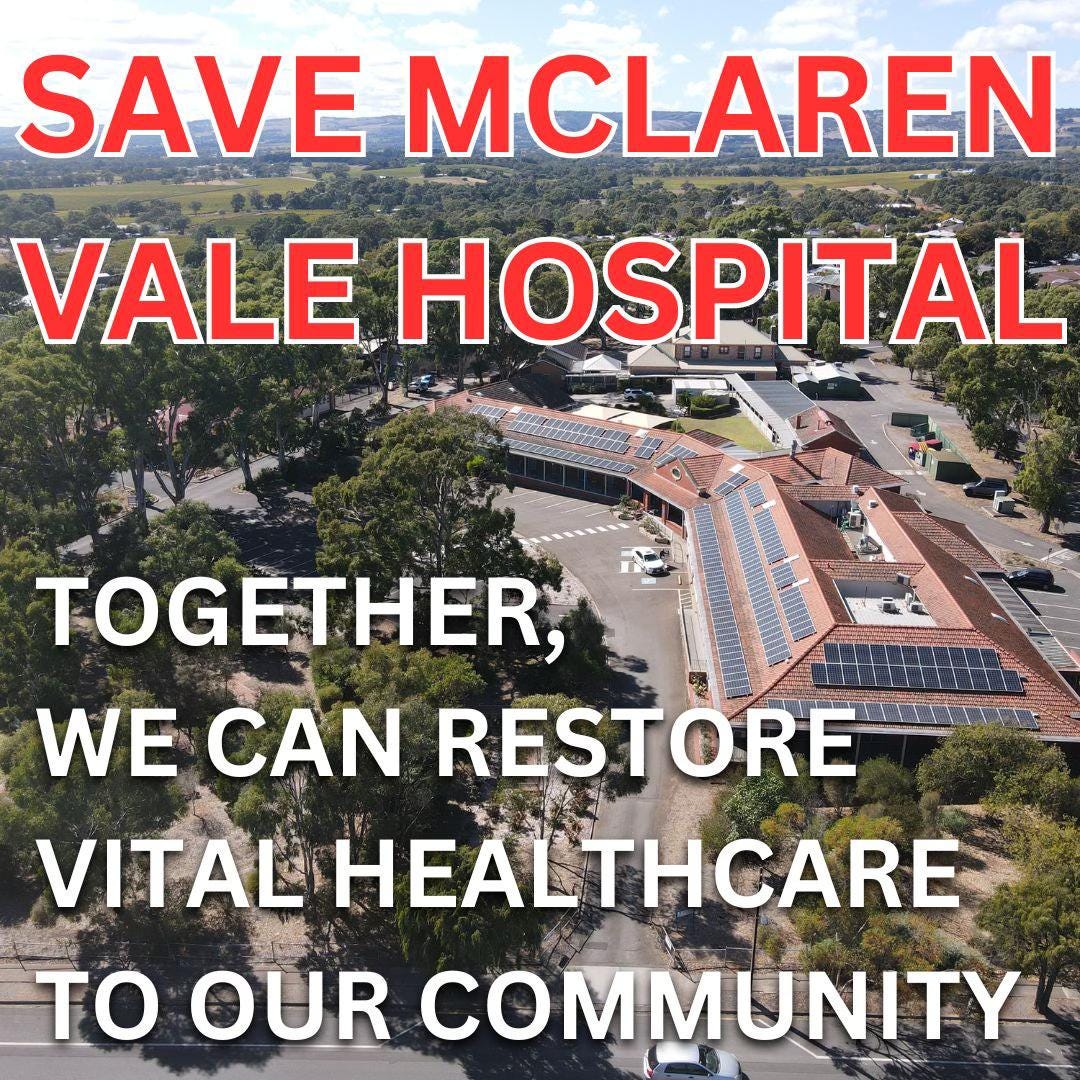“I think the board intentionally caused the vote to fail on Wednesday night in an attempt to blow it up and have the whole process start again.”
That is how Mr Henry Davis opened his response video to the collapse of the election of four new board members of the McLaren Vale & Districts War Memorial Hospital Incorporated last Wednesday night.
Mr Davis’s words have struck a nerve, echoing the simmering frustration that’s gripped specific segments of McLaren Vale for over twelve months. What was once a close-knit community has splintered into bitter factions, with allegations of secrecy and manipulation casting a long shadow over every decision. The board’s handling of the hospital's future and refusal to listen to dissent has ignited a fierce outcry, thrusting this rural institution into the spotlight of an ongoing courtroom drama that almost no one knows anything about.
In a ruling that rocked the small town of McLaren Vale, the South Australian Supreme Court found that the Board of the McLaren Vale Hospital acted in ways that were “oppressive and unreasonable” in handling the hospital’s assets. The Court’s findings follow months of escalating public outcry, fraught legal disputes, and allegations of secrecy and misconduct. What should have been a transparent decision about the future of a treasured community hospital has become a case study of what can go wrong when community trust meets corporate manoeuvring.
McLaren Vale residents have long known that the hospital was struggling. Faced with persistent funding issues, a revolving door of medical staff, and an aging facility, many understood that the Board had difficult choices. However, few anticipated the Board’s dramatic decision to close the hospital in the middle of last year, nor did the subsequent efforts to transfer its assets to the James Brown Memorial Trust (JBMT), trading under the name KALYRA. According to Auxiliary Justice Bochner, this arrangement was riddled with misrepresentations and lacked a genuine community mandate.
A Surprise Decision
In January 2023, the Board decided to close the hospital. According to Board Chair Mr Chris Overland, the reasons were clear: financial instability, staff shortages, and an inability to provide sustainable health services. However, as the Court later found, this was no ordinary business decision; it would effectively end the Board’s capacity to deliver the “viable and sustainable healthcare service” it was bound to by its constitution.
From the start, Overland and the Board moved swiftly to line up a plan to transfer the hospital’s assets to KALYRA, presenting the deal to members as a necessary “merger.” Yet, in a scathing critique of this term, Justice Bochner noted that it was “a shorthand way of saying transferring assets and undertaking of the hospital to KALYRA outright,” a description that falls far short of an actual merger.
“This was not a merger,” Justice Bochner wrote in her judgment. “It was an outright transfer that would deprive members of their rights and erase the hospital’s legacy as a community institution.”
When reached for comment, Overland declined an interview because the matter was “before the courts.” Yet documents uncovered in the trial reveal that Overland may have sought to frame the transfer to KALYRA as the only viable option, effectively sidelining other potential solutions. In an email to Board members, Overland noted that “the future of the hospital’s site is with JBMT,” adding that “any other proposal risks destabilising the trust we have built with KALYRA.”
Rallying Against the Transfer
The reaction from the community was swift: a group of passionate dissenting Hospital Association members formed, led by Mr Henry Davis, a lawyer and Adelaide City Councillor. The group included lifelong McLaren Vale resident Ms Trish Tassie, a descendant by marriage of the hospital’s first and founding doctor, Company director, Mr Micheal Baragwanath, and others who quickly emerged as vocal opponents to the Board’s plans. Davis condemned the Board’s actions, urging the community to resist what he called a “fast-tracked giveaway” of the hospital’s legacy.
“This isn’t about what’s best for McLaren Vale,” Davis stated. “This is about the Board lining up a deal they were set on from the start, without asking us, without even considering other options.”
For his part, Baragwanath—a figure who had not previously been involved in local healthcare debates—described his efforts as a “fight to give the community a voice in deciding what happens to an asset they have supported and cherished for generations.”
As momentum grew, a vote on the KALYRA proposal at a special meeting in May 2023 was called. In a narrow but significant victory, members voted down the proposal. Yet, as court documents later revealed, this victory was short-lived.
A Tactical Return
Within days of the May vote, the Board met informally to discuss how to resurrect the KALYRA proposal. An email exchange between Board members from early May reveals a coordinated effort to bring the proposal back to a vote under slightly different terms. In the preamble to this second vote, active support for the deal came from Dr Laureen Lawlor-Smith, the owner of the allied medical practice Wellbeing. Wellbeing leases a revamped section of the main hospital building. At this time, a second vote was called on the matter.
According to the Court’s findings, the Board then quietly set the wheels in motion, working closely with Dr. Lawlor-Smith to organise a new special meeting for July 2023, at which the KALYRA proposal would again be up for vote. What followed was an aggressive membership drive led by Lawlor-Smith, who was made aware by the Board of a critical cutoff date for new members eligible to vote at the meeting. While Lawlor-Smith and her team recruited, other community members were left in the dark about the urgency of the deadline. By the time notice of the July meeting reached members, the deadline for new members was less than a week away.
Justice Bochner’s ruling strongly condemned this sequence of events, calling it “unreasonable” and “oppressive.” She noted, “This was a calculated attempt by the Board to tilt the scales in favour of their preferred outcome. By coordinating with Dr Lawlor-Smith and failing to inform all members equally, the Board deprived the community of a fair process.”
A Hostile July Vote
The second meeting in July went forward with a drastically inflated membership from those recruited by Lawlor-Smith. The result was stark: a sweeping majority voted in favour of the KALYRA deal, effectively overturning the outcome of the May vote. For many members present, the atmosphere at the meeting was one of hostility. Many supporters of the KALYRA proposal believe that Davis and Baragwanath are aligned with commercial developers, a suspicion fuelled partly by Board communications that suggested only the KALYRA proposal would prevent a private takeover.
Davis recalled in his testimony that the July meeting was nothing short of a “railroad job.” According to his account, the vote took place without any substantial discussion of alternative options, and those opposing the KALYRA proposal were treated as “outsiders, intent on selling off the community’s assets.”
Davis reflected on the experience in his testimony, stating, “I didn’t expect a friendly reception, but I didn’t anticipate being treated as if I was trying to steal from the community. The Board set us up as the enemy.”
A Chilling AGM
As tension simmered in the months following the July vote, the Annual General Meeting held on October 30, 2024, promised to be a flashpoint. But once again, Davis and his allies were left out in the cold. According to Davis, existing Board members sought re-election when they were not eligible to do so and incorrect information was given to members about the ballot process. By night's end, the vote collapsed into such a mess that it had to be abandoned.
None of the Save McLaren Vale Hospital Group candidates secured seats on the Board, nor did any other factions. The Hospital appears rudderless, adrift and hemorrhaging funds for even more legal fees. The October AGM underscored how deeply divided the McLaren Vale community remains, with little chance of compromise while the KALYRA proposal remains on the table.
In her judgment, Justice Bochner expressed frustration at the Board’s refusal to engage in genuine dialogue, citing missed opportunities to bridge community divides. “At every juncture, the Board has chosen to double down on its decisions rather than meaningfully address the concerns raised by Mr. Davis, Mr. Baragwanath, and others,” Bochner wrote in her ruling.
Looking Forward and a Long Road to Reconciliation
Today, the hospital’s fate remains in limbo. While The Save McLaren Vale Hospital Group are still waiting for the court-ordered mediation to start, the Board has initiated further consultations with their legal advisors.
Given the past year's events, the Board’s sincerity must be widely questioned. Justice Bochner’s ruling recommends mediation and further consultations, but for those who feel betrayed, the scars of this conflict are likely to linger.
In one of his final statements to the Court, Davis summarised what he believes is at stake for McLaren Vale and all communities facing similar decisions.
“This is more than a building,” he said. “It’s about whether we get a say in the future of our communities or if those decisions will be made for us, behind closed doors, by those who have no stake in our lives.”
As the fight for McLaren Vale Hospital’s future continues, one thing remains clear: the residents of this small Adelaide commuting town, in the heart of one of South Australia’s world-renowned wine regions, have been reminded that community ownership can be fragile. And once lost, it may be gone for good.









Thank you finally you have provided clarity to this tragic mess instead of the mishmash of posts coming through on the internet! Hopefully a successful outcome can be reached & a new board can be elected with the right knowledge, decision making processes & openness for this valuable community asset!
What a great article. You have told the story well. This fantastic community asset need to remain community owned & operated. It needs to be kept in community hands so it can be passed on to the the future generations. Thank you.